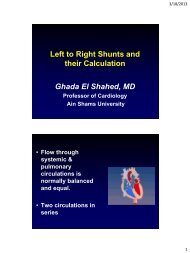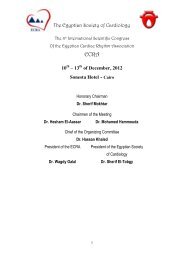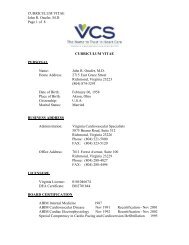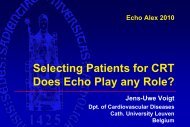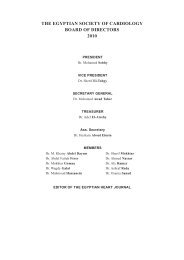training in cardiac electrophysiology and pacing - Cardioegypt.com
training in cardiac electrophysiology and pacing - Cardioegypt.com
training in cardiac electrophysiology and pacing - Cardioegypt.com
You also want an ePaper? Increase the reach of your titles
YUMPU automatically turns print PDFs into web optimized ePapers that Google loves.
4-‐ Certification for practice of <strong>cardiac</strong> <strong>electrophysiology</strong> <strong>and</strong> pac<strong>in</strong>g<br />
A certificate offered by the Egyptian Society of Cardiology <strong>and</strong> the Egyptian Medical<br />
Syndicate for <strong>in</strong>dependent practice <strong>in</strong> <strong>cardiac</strong> <strong>electrophysiology</strong> <strong>and</strong> pac<strong>in</strong>g will be offered to<br />
specialists <strong>in</strong> Cardiovascular Medic<strong>in</strong>e upon <strong>com</strong>pletion of the follow<strong>in</strong>g requirements:<br />
i. Obta<strong>in</strong><strong>in</strong>g a Master/MD degree <strong>in</strong> cardiovascular medic<strong>in</strong>e from one of the cardiology<br />
departments <strong>in</strong> Egyptian universities or an Egyptian fellowship <strong>in</strong> cardiovascular<br />
medic<strong>in</strong>e from the board of medical education <strong>and</strong> fellowship, M<strong>in</strong>istry of Health.<br />
ii. Completion of level 2 <strong>and</strong> 3 <strong>tra<strong>in</strong><strong>in</strong>g</strong> <strong>in</strong> Cardiac <strong>electrophysiology</strong> <strong>and</strong> pac<strong>in</strong>g as detailed<br />
below (section V).<br />
III. Core syllabus <strong>in</strong> Cardiovascular medic<strong>in</strong>e<br />
1. Global burden of cardiovascular disease:<br />
• Economic, social <strong>and</strong> demographic transitions<br />
• Rate of changed of epidemiologic transition<br />
• Current worldwide variations <strong>in</strong> the global burden of cardiovascular disease<br />
• Global trends <strong>in</strong> cardiovascular disease<br />
• Regional trends <strong>in</strong> risk factors<br />
2. History <strong>and</strong> physical exam<strong>in</strong>ation of the cardiovascular system:<br />
• Card<strong>in</strong>al symptoms of heart disease<br />
• The history <strong>in</strong> specific forms of heart disease<br />
• Assess<strong>in</strong>g cardiovascular disability<br />
• Physical exam<strong>in</strong>ation of the heart <strong>and</strong> circulation<br />
• The general physical exam<strong>in</strong>ation<br />
• The <strong>cardiac</strong> exam<strong>in</strong>ation<br />
3. Electrocardiography<br />
• Fundamental pr<strong>in</strong>ciples<br />
• Record<strong>in</strong>g electrodes <strong>and</strong> leads<br />
• Cl<strong>in</strong>ical electrocardiographic lead systems<br />
• The electrical axis<br />
• The normal electrocardiogram<br />
• The abnormal electrocardiogram<br />
• Cl<strong>in</strong>ical issues <strong>in</strong> electrocardiographic <strong>in</strong>terpretation<br />
4. Exercise stress test<strong>in</strong>g:<br />
• Exercise physiology



